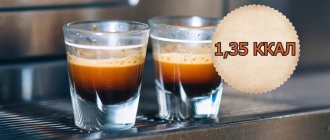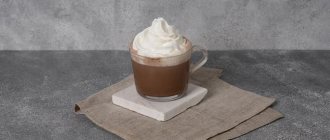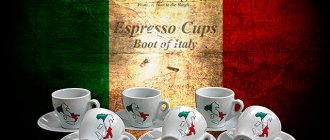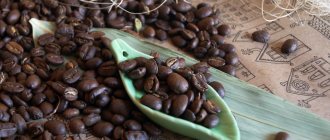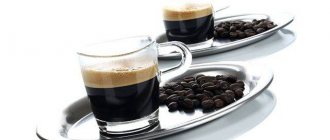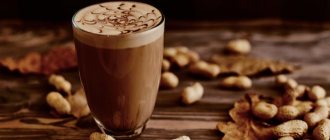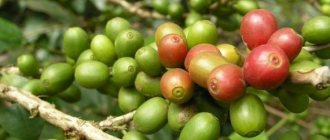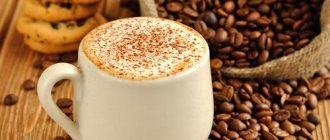Cappuccino is an Italian espresso-based coffee drink. The classic version includes a double portion of black coffee, hot milk and thick milk foam, but some baristas use cream instead of the last two ingredients, and also add cinnamon, chocolate chips, and orange zest to the drink.
Cappuccino has a mild taste with a slight coffee bitterness. If everything is done correctly, the drink should turn out sweet even without adding sugar (due to the fatty milk foamed by the cappuccino maker).
Interesting fact: despite the apparent simplicity of the recipe, making cappuccino is quite difficult. At international barista and coffee competitions, masters often compete in preparing this particular drink.
Cappuccino coffee - what is it?
The tradition of adding milk to strong coffee to soften the harshness of the taste appeared around the 17th century. We do not have reliable information about who and when became the author of this innovation. But already from the end of the 18th century, coffee with milk was served in all existing coffee houses in Europe.
Cappuccino is a term of Italian origin. Translated, it means “Capuchin”, so the name is associated with the order of Capuchin monks. It was experimentally found that if a well-mixed mixture of milk and cream was added to coffee, a stable foam in the shape of a small pyramid formed on the surface. Because of its resemblance to the white pointed hoods of the Capuchin monks, the coffee was nicknamed “cappuccino.”
The appearance of devices for frothing milk into foam subsequently raised the recipe to the heights of popularity. By the middle of the 20th century, cappuccino became one of the favorite coffee drinks, and it remains so to this day.
Composition of cappuccino coffee
The list of main ingredients for cappuccino consists of only two items:
Freshly brewed coffee
You can take a shot of espresso, brew coffee in a cezve, geyser coffee maker, or simply brew it in a French press. A prerequisite: hand-brewed coffee must be strained so that particles of grounds do not interfere with the enjoyment of your cappuccino.
Milk
The milk should be frothed or frothed until half of its volume is reduced to a smooth, stable foam. You can take milk of any fat content. If you are making cappuccino at home and want to achieve a good, stable and smooth foam without using a cappuccino machine, then choose a mixture of cream and milk in a 1:1 ratio.
Additional cappuccino ingredients:
- Sugar - cane or caramelized sugar complements the taste of the drink well.
- Decorative topping - the most popular topping for cappuccino is cocoa or cinnamon. Both ingredients can be mixed with powdered sugar.
Cappuccino coffee recipe
A classic cappuccino is made with espresso.
Cappuccino proportions:
- 1/3 coffee.
- 1/3 milk.
- 1/3 milk foam.
What is needed to prepare the drink?
- Espresso - 40-50 ml.
- Milk – 80-100 ml.
- Sugar - to taste.
- Flavorings and toppings are optional.
How to make cappuccino?
- Brew a 40-50 ml portion of espresso.
- Pour cooled milk at a temperature of 4-5 degrees into the cappuccino maker and beat until it forms a dense and smooth foam with a finely porous structure. This increases the temperature of the milk, so it is important not to overheat the milk when frothing. It should have a final temperature of 65-75 degrees.
- Pour the prepared coffee into a heated cup, then the milk, and place the remaining foam on the surface of the drink.
- Decorate with sprinkles.
Flavored cappuccino is prepared using the same technology, but topping is added - caramel, chocolate, vanilla or cream. The topping is poured into the coffee before adding the milk.
Cappuccino can be decorated with latte art designs.
Cooking technology
- A tall coffee glass or cup with a volume of 180 ml or more is heated with steam and a double portion of espresso coffee is poured into it.
- Milk heated to 60-70 degrees is whipped using a whisk, mixer or cappuccino maker until it becomes fine foam, until the volume doubles.
- Use a spoon to hold the foam and pour the milk into the coffee, add coffee if desired and stir.
- Spread milk foam on top and sprinkle with cinnamon.
Most coffee machines already have a cappuccino maker, but there is also a manual option. Its principle of operation is the operation of a spray bottle that mixes steam with milk, creating the thickest and most delicate foam.
Cappuccino coffee at home: recipe
How to make cappuccino at home if you don’t have a coffee machine with a cappuccino maker? You'll have to resort to a proven old recipe.
- Prepare strong coffee in a cezve or French press at the rate of 2 teaspoons per 100 ml of water.
- Mix 50 ml of milk and 50 ml of cream with a fat content of 10-15%.
- Heat the milk and cream mixture in the microwave for 30-60 seconds. The mixture should be hot, but not boiling.
- Using a mixer, immersion blender or whisk, beat the milk-cream mixture for 3-4 minutes until you get a thick, smooth, shiny foam with small bubbles.
- Strain the brewed coffee.
- Pour 50 ml of coffee into a heated cup, then pour in the milk and top with foam.
- Mix cocoa with powdered sugar. Garnish the cappuccino with the resulting topping.
Sugar for cappuccino is served separately.
If you decide to flavor your drink by adding topping, add the flavored syrup before adding the milk.
Making cappuccino
Cappuccino is essentially espresso with frothed milk. This is the simplest definition of this coffee drink. When frothing milk for cappuccino, the first stage - aerating the milk - is made shorter so that it is more liquid.
Algorithm for making cappuccino:
- First you need to take the pitcher and pour the required amount of milk into it.
- Then brew espresso in a glass.
- After, or simultaneously with preparing espresso, froth the milk.
- And then you need to pour the milk into the espresso.
- The cappuccino is ready.
Classic cappuccino in a coffee machine
Using a coffee machine you can make a high-quality and tasty drink at home. To prepare it, you only need to brew 30 ml of espresso and add 60 ml of milk. The espresso cup is preheated. Milk is added to the pitcher, and then the milk is whipped using a steam heater - it should spin like a funnel. Then the finished espresso is carefully poured into the milk, and then you can serve the coffee in the cup.
Original with egg foam
This recipe differs from the previous one only in that the foam is made in a slightly different way. Separate the white from the yolk, and then beat it together with 2 teaspoons of sugar until everything turns into a homogeneous mass. You can use a whisk or blender for this. Then the prepared espresso is poured into the cup and 30 ml of heated milk is added. The whites are carefully placed on top of the cup in a heap. Next, you can add any decorations or creative elements. For example, you can add a little cocoa and make a drawing.
Without coffee machine
If you don't have a coffee machine at home, you can still make this delicious and magical drink. You can brew coffee in a Turkish pot: to make the taste richer, bring the coffee to a boil 2-3 times. You can also use a French press. In any case, strain the resulting espresso and then pour it into a warm container. Next, heat the milk and beat it with a mixer or blender until smooth. Pour the resulting mixture into coffee.
Double
To make the drink stronger, pre-brew a double shot of espresso. The milk is heated a little less than usual and then whisked (there is no need to remove the milk from the heat). After this, the finished milk is added to the espresso.
Traditional
The traditional recipe also requires you to brew the espresso in advance and strain it.
The milk is heated to a boil and then whipped with a blender until foam forms. Milk is poured into the coffee, and the foam is adhered to with a spoon. The foam should be placed separately on the coffee, and cinnamon can be added on top. The foam itself should not sag.
Creamy vanilla
In this recipe, milk is replaced with cream, which whips much faster.
The recipe uses 50 ml of coffee to make espresso, 50 ml of heavy cream (30% is better), and sugar is added to taste. The cream is heated to a boil, and then sugar is added to it. The resulting mass is whipped until foam forms, and then the cream is poured into a cup of ready-made espresso.
Cappuccino Fredo
For this drink, prepare a tall transparent glass and find a shaker in advance.
Fredo contains 60 ml espresso, 60 ml milk, ice, whipped cream and syrup (it is better to choose caramel). The brewed coffee is cooled to room temperature and then poured into a shaker. Cold milk and syrup are also added here - you need to shake the composition for 10-15 seconds. Next, crushed ice is added and the whole mixture is shaken for about 30 seconds. The resulting drink is decorated with whipped cream.
Kokochino
This recipe will convey the warm atmosphere of the summer season. In addition to milk and coffee, coconut syrup is also used (20 ml per 60 ml of espresso is enough). The coffee must first be brewed and strained, and then poured into a cup where the syrup has previously been added. Whisk the milk and add it to the resulting drink.
Bicherin
This is another version of the cocktail, which is made on the basis of cappuccino. Served in a tall glass. As usual, espresso is brewed and strained. Add milk, chocolate and cream to a separate cup - put on fire and cook for 1 minute. The glass is filled 1/3 with the resulting chocolate. Coffee is carefully poured into the next layer, and the entire composition is decorated with whipped cream. You can also add grated chocolate on top.
Marocino
This is a simpler version of the previous recipe. This dessert should be served in small portions. Espresso is brewed separately in a convenient way. Place cocoa powder in the cup where the coffee will be poured, and then pour espresso into it. Gently mix the mixture. Heat the milk separately until foam appears - then add it to the cup. The top of the drink can be decorated with cocoa powder.
Spicy
To get a new taste, the drink can be enriched with spices and seasonings. In a Turk, prepare a mixture of ground coffee, spices and clean water. Brew and strain the espresso, then pour it into a warm cup. Whisk the milk until foamy. Melt the chocolate in a microwave oven or in a water bath. Then gradually combine the melted chocolate with heated milk, and pour the resulting mixture into the coffee.
Mocha and mochaccino
This version of the recipe is somewhat reminiscent of previous drinks using chocolate. You need to brew espresso using a convenient method, and also melt chocolate using a water bath or microwave. The milk is also heated. Hot chocolate is first poured into a large coffee glass, the next layer is warmed milk, and coffee finishes everything off. You can decorate the composition with whipped cream and chocolate chips.
Instant coffee cappuccino
Is it possible to make cappuccino from instant coffee? Technically, it’s possible, but the taste and aroma of such a drink will be far from real cappuccino. Instant ersatz cannot replace natural coffee.
If you decide to do such an experiment, then first boil water and prepare instant coffee at the rate of 1 teaspoon per 50 ml of water. You can immediately add topping to your coffee to improve the taste.
Then froth the milk using a cappuccino maker. If you don’t have this device at hand, then heat the mixture of cream and milk and beat with a blender or mixer until foam forms.
Pour the coffee into a heated cup, then add frothed milk and add foam on top. A sprinkle of cocoa or cinnamon will decorate your cappuccino.
Classic recipe
Making cappuccino coffee at home is not difficult. The process will consist of several steps.
- Making espresso
- Making foam from milk
- Combining coffee with foam
- Decorating the drink with auxiliary ingredients
How to make cappuccino coffee? Next we will consider this issue in detail. Espresso at home can be brewed in a Turk. Espresso coffee ingredients: 125 ml water, 35 g ground beans. For lovers of a strong drink, you can increase the dose of powder to 40-45 g. To feel the energy of the drink, you should bring the liquid to a boil 2-3 times. In this case, the strength of the coffee will increase each time.
It is advisable to prepare foam from full-fat milk (at least 2.4% fat content). Take a hot drink, pour it into a blender or mixer, and beat. If you have a cappuccino maker, the procedure will be much easier. It will take less time to obtain airy foam than to form it using a whisk or any of the above devices. At first, the thought arises that the process is useless, but you must have patience. After a few minutes, large bubbles will appear, then a thick foam with small bubbles will appear. This is exactly the kind of foam you need for cappuccino.
The next step is to “assemble” the drink from the ingredients. To do this, prepare ceramic and porcelain dishes. Rinse the cup with hot water to warm it up. Pour hot espresso into it. The next thing to do is pour milk in a thin stream to form a new layer. And cover everything on top with foam.
You can decorate the cappuccino with a regular design (in the form of a heart, cherry, flowers, apple, inscription, etc.) with or without a stencil. For the image on the foam, cocoa, cinnamon, and chocolate chips are used.
For those who have a sweet tooth, experts advise adding sugar at the end, when the foam is already in the drink.
Calorie content of cappuccino coffee
The calorie content of cappuccino varies depending on the fat content of the milk, the presence or absence of sugar, and topping.
Cappuccino calorie table
| Composition of the drink | Calorie content of 100 ml cappuccino | Calorie content of a serving of cappuccino (150 ml) |
| Cappuccino with milk 2.5% fat | 36 kcal | 54 kcal |
| Cappuccino with milk 3.2% fat | 41 kcal | 61 kcal |
| Cappuccino with a mixture of milk and cream 10% fat | 60 kcal | 90 kcal |
| Cappuccino with 1 tsp. Sahara | 50 kcal | 74 kcal |
| Cappuccino with sugar and cocoa sprinkles | 54 kcal | 80 kcal |
| Cappuccino with flavoring (topping) without sugar | 54 kcal | 80 kcal |
| Cappuccino with flavoring (topping) and sugar | 67 kcal | 100 kcal |
How much caffeine is in cappuccino
Caffeine is an essential component of all drinks based on natural coffee. Cappuccino is no exception to the rule. Its caffeine content varies from 40 to 70 mg .
Cappuccino made from ground Arabica beans will be slightly less strong due to less caffeine saturation of the beans. If a mixture of Arabica and Robusta was used to prepare the drink, then such coffee contains more stimulating alkaloid, since Robusta has a higher percentage of caffeine than Arabica.
What affects the amount of substance
Bean variety
To understand how much caffeine is in a cup of coffee, pay attention to the type of beans from which it is made.
Let's consider how much alkaloid the known coffee varieties contain. The calculation is for 1 serving of 180 grams:
- Arabica – 177 mg.
- Java Arabica – 187 mg.
- Venezuela – 192 mg.
- El Salvador – 187 mg.
- Haitian – 201 mg.
- Santos – 160 mg.
- Guatemala – 187 mg.
- Robusta (Uganda) – 325 mg.
- Robusta (Congo) – 325 mg.
- Cameroon – 180 mg.
- Peru – 170 mg.
- Colombia – 195 mg.
- Nicaragua – 180 mg.
- Costa Rica – 170 mg.
- Mocha (Ethiopia) – 160 mg.
- Meleber (India) – 195 mg.
- Cuban – 195 mg.
- Minas – 163 mg.
- Mexican – 170 mg.
As you can see, the dose of caffeine depends on where the beans grow. Find out more in the article “Where Coffee Really Grows.”
Be more careful when choosing a pack of whole or ground grains in the store.
Roasting degree
The amount of invigorating substance contained in the finished drink also depends on how long the grains were roasted.
The caffeine content of coffee can be judged by the color of the beans. The darker they are, the more enzyme they contain, and vice versa - in lighter grains its level will be lower.
Grinding
There are 2 more factors that affect the amount of caffeine in coffee. The first is the degree of grinding. The finer it is, the more substances the ground natural powder will release into the water, and the concentration of caffeine in one serving will be greater.
It is also important how long ago the raw materials were prepared. Liquid from freshly ground beans will be stronger - 60 mg per cup. Grains that have been ground for 2-7 days lose 10-30% of their substance.
Cooking and brewing techniques
The more water used to prepare a coffee drink, the less alkaloid it contains. This opinion is not correct. Everything depends not on the volume of the liquid, but on its temperature. The higher it is, the more substances the ground powder gives to water.
The next factor that is responsible for the strength is the cooking time. Espresso brewed in a coffee machine is less strong than the one prepared in a Turkish coffee machine. The least invigorating alkaloid in ristretto is 10-15 milligrams, since it is prepared in 15-20 seconds using steam.
Is it possible for pregnant women and children to have cappuccino?
The milk in cappuccino leads many people to believe that the drink has no restrictions on its consumption. The milk component does not replace the presence of a significant dose of caffeine in cappuccino . Milk only softens the effect of caffeine, reducing the severity of its effects.
The caffeine contained in cappuccino can have a stimulating effect on the nervous system, which is especially vulnerable in pregnant women and children. It is better for them to refrain from drinking cappuccino, as well as all other types of coffee-containing drinks, so as not to put their health at risk.
Pregnant women and children should choose cocoa or hot chocolate instead of cappuccino.
What happens if you drink a lot of caffeinated drinks?
Doctors believe that up to 400 mg of the substance can be consumed per day without harm to the body. This is 3-5 mugs. This amount of invigorating alkaloid will help you stay in good shape all day without side effects.
If you exceed the norm, health problems may appear: outbreaks of paranoia or unreasonable anxiety, which will lead to chronic insomnia. Coffee mixes can cause pressure surges and prolonged headaches.
Coffee flushes calcium from the body.
The bone tissue becomes softer, and cracks may appear on the bones. To avoid this, drink 1 glass of milk a day.
Remember that instant powder contains more caffeine than natural powder. Often the information on the label about the composition of the product is false, so as not to scare away buyers. If you want to reduce the amount of enzyme in one cup, add cream or milk.
Cappuccino coffee cups
Cappuccino is a voluminous drink, so 180-200 ml cups are suitable for serving it. You can take larger containers, but the peculiarity of serving cappuccino is that the milk foam should not only be flush with the edge of the cup, but even slightly protrude beyond its edge. Therefore, dishes should be selected based on the portion that is prepared in your kitchen.
- Preference is given to cups in the shape of an inverted dome, with an extension at the top. In such dishes, the patterns on the surface of the cappuccino are clearly visible.
- Sometimes cappuccino is served in glass glasses for Irish coffee. The height of the foam is clearly visible in them.
- The best glassware for cappuccino remains ceramic cups with thick walls. In them, the drink retains its temperature longer, while in glass glasses the coffee cools down faster.
Traditional glassware for cappuccino is a white ceramic cup with a volume of 200 ml with thick walls.
Cappuccino: difference from other coffee recipes
A cappuccino recipe is one of the options for coffee-containing drinks, of which there are a great variety. What is the difference between the most popular traditional coffee menu recipes?
What is the difference between a cappuccino and a latte?
- Proportions. A latte contains much more milk than a cappuccino. A latte contains only 1/5 coffee and 4/5 milk.
- Cooking method. A latte is made by adding coffee to milk. To make cappuccino, on the contrary, milk is poured into coffee.
- Volume. A latte serving is approximately 350-380 ml, sometimes more. Cappuccino is served in portions from 180 to 250 ml.
- The latte tastes milky and sweet. The influence of coffee on the bouquet of the drink is minimal. The taste of cappuccino is coffee and milk, the coffee in it is felt brightly.
What is the difference between a cappuccino and a mochaccino?
- Compound. Mochaccino, in addition to coffee and milk, includes chocolate syrup or hot chocolate.
- Proportions. Mochaccino contains approximately ¼ part coffee and ¾ other ingredients. Compared to cappuccino, the share of coffee is reduced.
- Cooking method. In mochaccino, coffee is added after milk and chocolate, unlike cappuccino.
- Taste. The bouquet of mochaccino is chocolate-milk, sweet, with coffee notes, it differs from the coffee-milk taste of cappuccino.
What is the difference between a cappuccino and an Americano?
- Compound. Americano does not have foamed milk or a high head of foam; only espresso, heavily diluted with water, is used to make it.
- Taste. Americano has a weakened coffee taste, without the dairy component. Even if Americano is diluted with milk, it will be very different from the bright coffee and milk flavor of cappuccino.
What is the difference between cappuccino and espresso?
- Compound. Espresso is coffee brewed in an automatic coffee machine. Prepared without additives, it is the basis for many other coffee drinks, including cappuccino.
- Volume. A serving of espresso ranges from 40 to 80 ml. A cappuccino has a volume of at least 150 ml and can go up to 250 ml.
What is the difference between a cappuccino and a macchiato?
- Proportions. Macchiato, like cappuccino, contains foamed milk, but in much smaller quantities. The classic macchiato recipe is 1/3 milk and 2/3 coffee, while a cappuccino is 1/3 coffee and 2/3 milk.
- Taste. Milk in a macchiato only emphasizes the bouquet of coffee, while milk in a cappuccino significantly softens the harshness of the coffee, blurring the richness of the coffee.
- Cooking method. To obtain a macchiato, coffee is poured into a small portion of frothed milk to create the characteristic coffee stains on the surface of the foam, which give the drink its name. "Macchiato" means "spotted" in Italian.
What is the difference between cappuccino and coffee with milk?
- Cooking method. For cappuccino, milk is frothed using a blender or cappuccino maker.
- Compound. In cappuccino, approximately 1/3 is delicate milk foam, which gives the drink a special taste and recognizable appearance. Coffee with milk does not contain whipped foam.
- Proportions. The milk component for coffee with milk can be anything - half a cup or one tablespoon. The proportions of a classic cappuccino are regulated: 1/3 milk, 1/3 coffee, 1/3 milk foam.
What is the difference between cappuccino and raf coffee?
- Compound. Rough coffee is made from cream, coffee and sugar. The composition of cappuccino is milk and coffee, cream is used much less frequently, and sugar is added as desired.
- Cooking method. To prepare raf coffee, all ingredients are mixed and whipped. For cappuccino, only milk is frothed.
What is cappuccino coffee? Features, composition, types and how to prepare the drink
Today we will learn what cappuccino coffee is, what features and composition it has, how to prepare it correctly, and also what is the history of the origin of the coffee drink
WHAT IS COFFEE CAPPUCCINO. FEATURES, COMPOSITION, TYPES AND HOW TO PREPARATE THE DRINK
Good afternoon, today we will learn what cappuccino coffee
, what
features
and
composition
it has, how to
prepare it
, and also what is
the history of the origin
of the coffee drink.
In addition, we will tell you about the beneficial
properties contained in
cappuccino
the ratio of ingredients
should be , as well as
the benefits
and
harms
of this type of
coffee
for the human body.
In conclusion, let's talk about the calorie content of cappuccino
, how
often
you can
drink
a coffee drink and what is the key
difference between
this type of
coffee
and others.
Thanks to the rapid
coffee drinking
culture , our everyday
vocabulary
is increasingly filled with new
recipes
and
types of
coffee drinks.
For example, thanks to experiments
that are constantly carried out
by connoisseurs
types
of coffee as
latte
,
ristretto
,
mocha
and
cappuccino
were born .
Each type of
coffee drink means a special
method
of preparation, using
milk
,
chocolate
,
syrup
and other aromatic and tasty
additives
.
For reference, we note that professional baristas
who prepare
coffee
believe that
there is a stable
connection
type of
coffee drink and
character , which
speaks
of certain
qualities
of a coffee lover.
HOW DOES COFFEE AFFECT THE HUMAN BODY?
HOW TO PROPERLY STORE COFFEE
Among the many species
coffee desserts, especially
cappuccino
, which is one of the most
unusual
,
original
and
sweet
drinks.
Due to the fact that the ingredients
necessary to
create
delicious and aromatic
cappuccino coffee
are almost always
at hand
, it is very
easy
to prepare at
home
.
Cappuccino
is
a type of
unique
coffee
dessert that can be
consumed
in the morning, afternoon, and also in the evening, albeit within
reasonable
limits, because
the caffeine
although
minimal
, is still present.
As we already understood, answering
the question: “
What is
cappuccino?” “, we can confidently say that this is
an unusual
coffee drink
of Italian
cuisine,
prepared
on the basis of
espresso
with
the addition
of heated and always frothed
milk
.
For reference, we note that the name cappuccino coffee
comes from the Italian word
cappuccino
, and
we must
Capuchin
monks the creation of , who invented this wonderful and beloved
coffee dessert
.
1. HISTORY OF ORIGIN OF COFFEE CAPPUCCINO
To date, accurate information
There is no such thing
regarding the origin of
coffee beans Some lovers
of the aromatic drink
claim
that the birthplace of
coffee
is one of the countries
of the African
continent - modern
Ethiopia
or
Kenya
, while other
connoisseurs
of the invigorating product
consider
Brazil
to be the ancestor
of
coffee beans
. It so happened according to legend
that
the first
discover
wild
coffee
plants local
shepherds
who grazed their goats.
It was the goats
of the shepherds who initially fed on
fruits
, or rather
grains
and
leaves
from
coffee
trees.
Then the shepherds decided
to
taste fruits
of these unusual
plants
and began
to brew
coffee
leaves
with
beans
.
The finished decoctions
had a very specific
bitterness
the taste
strength
at that time , which greatly
spoiled
the aroma of the drink.
Later, the lack of bitterness
was
eliminated
by the first lovers
of the coffee by adding
goat's milk
.
The drink brewed
from
coffee beans
with the addition of
milk
has become much more
pleasant
and
softer
in
taste
.
Thus, some coffee lovers
They believe that
thanks
for the creation of
cappuccino
, it is necessary to thank
the shepherds
who invented
adding
goat's
milk
coffee
from
the leaves
and
beans
of coffee plants .
However, this information is more considered a legend
that was passed from one generation to another.
a more plausible
story of the origin of
cappuccino coffee
is information associated
with monks
from the
Capuchin
, dating back to
the Middle
Ages.
Capuchin
monks began its existence in
1525
, based on
the chronicles
of the monastic brotherhood
of the Franciscans
almost all
European
clergy
at that time
belonged The Capuchins
were
Italian
monks who wanted to bring
reforms
to the then
Catholic
Church.
It is believed that they were the supporters
of everything
new
, not only in
the church
and
faith
, but also in many
areas
connected with
the life
of ordinary townspeople.
As we remember from history, the leaders of the Catholic Church
(
for reference: popes
) in the Middle Ages
did not particularly
support various kinds
of innovations
that could
affect
the
governance
of the people.
Therefore, initially,
coffee was outlawed by the Pope, Clement VII,
that
is
,
the coffee
drink
was automatically
banned
in many
monasteries
and
parishes
.
As we know, to whatever order
monks
were not involved , but they are also
people
and once you try
a good
drink, which is rightfully
considered
coffee
,
you
quickly
get used
to it .
Therefore, in order to circumvent
the prohibitions
of the Catholic
Pope,
the Capuchins
began
to add
milk
to the prepared
coffee
drink .
According to medieval chronicles
, when
Pope Clement VII
tried
coffee
with
milk
in
1529 , he secretly
approved
the new
drink
for his monks.
In addition, the prepared coffee
with
milk
almost completely
coincided
in
color
with the main colors
Capuchin
Order for reference: the main colors of the Capuchin Order are white and brown
).
Thus, it is believed that 1529
is the date that marked
the beginning of
a new
type
of coffee drink, which later received the name
cappuccino
, in
honor of
the monastic order of
the Capuchins
.
Today we can confidently say that the Capuchin
made
a significant
contribution to the history
of the development of
coffee drinks.
After many centuries, coffee
began to be drunk all over the planet.
For reference, we note that only decades later the coffee
drink began
to be called
exclusively by
its Italian
name -
cappuccino coffee
.
To this day, the recipe for
cappuccino
coffee virtually
no
major
changes
, except for stronger
heating
and
frothing
of milk.
It is believed that the most important highlight
of a real
cappuccino
is
the milk foam
that
is located
on
the surface
of the coffee.
Properly prepared
foam
should not
dissolve
quickly ; it should
retain
the heat
of the drink
underneath it.
2. FEATURES, COMPOSITION AND HOW TO PREPARE CAPPUCCINO COFFEE CORRECTLY
So after we know what the story
origin of
cappuccino coffee
, you need to figure out what is so
special
about this
coffee
drink.
The most important
feature of a real
cappuccino
is the
ratio
of ingredients, since if
this
proportion
is violated , it will be a completely
different
type
of coffee
drink.
The composition of a cappuccino
must necessarily include
ground coffee beans
,
milk
(
for reference: with a fat content of at least 2.5%
) and
milk foam
.
Often cappuccino
is mistakenly
compared to
latte
, but we must understand that this is
not a correct
judgment, since
the ratio
(
proportion
) of ingredients in
coffee
drinks
is different
, which can be clearly
seen
in the image below.
The easiest way
to create a real
cappuccino
is to prepare
a coffee
drink using
a coffee machine
equipped with
a cappuccino maker
.
a coffee machine
at hand , then this is not a problem, since
you can
make
cappuccino coffee yourself
without resorting to the help of special
household appliances
.
In the process of preparing
a coffee dessert, we must remember that each
component
of the drink should be equal to
1/3
of
the total
volume of the cup or glass.
According to the rules,
espresso
coffee initially
poured into a pre-prepared
cup
, preferably made of porcelain .
Then milk
in a proportion of
1/3
of
the total
volume.
For reference, we note that
milk
poured
into a cup must be
brought
to
a boil
.
The most important
a component of any
cappuccino
is
milk foam
, which can be
obtained
by different
methods
of whipping (
for reference: manual or automatic
).
As we said earlier, good
crema
should not
dissolve in
the espresso
and
mix
with the drink.
The main task
of the foam is to
preserve
the heat
of the coffee
drink that
is
underneath it.
For reference, we note that in a properly
prepared
cappuccino
,
the upper
part
of the foam
will always be slightly
bitter
, and
the lower part
, on the contrary, will be
sweeter
.
After our three even
layers are ready,
the top one
, which contains
the foam,
can be
decorated
, for example,
sprinkled with
grated chocolate or cinnamon, if desired.
Decorating the foam
allows the finished
cappuccino
external
effect
, which is reflected in
the originality
and
uniqueness
of this
type
of coffee drink.
The above recipe
Making
cappuccino
is more of
a quick
, home-made
method
, which
may
not always perfect
and
tasty
.
If we want to prepare
a real
Italian cappuccino
and observe all
the subtleties
of this
beautiful
in appearance and
aromatic
in taste, we need to adhere to certain
rules
.
Initially, we brew espresso
in a classic copper
pot
with
a flat
bottom or using
a coffee machine
.
Then pour
1/3
of its
total
into
the ceramic
cup with just brewed
espresso
.
After this,
heated
milk
the espresso and it is advisable to
immediately
put
airy
foam
into the cup (
for reference:
in the third layer
). All ingredients
should be in
equal
proportion to each other -
1/3
to
the total
volume
of the cup
.
When creating a real Italian cappuccino
often professional
baristas
, using special
movements
on the surface
of the foam
, create an original
drawing
called
cappuccino art
.
We must remember that the quality of
the finished
coffee
drink is primarily affected by
the temperature
of the milk, its
consistency
and
the proportion
of ingredients.
The basis of the drink is laid in the proportional
ratio of
milk
and
espresso
.
Additionally, the texture
of the frothed
milk
should be
fine
and
similar
to
a glass
surface, and its
temperature
should be in the range of
60 -65 degrees
Celsius.
For reference, we note that when the optimal
temperature is reached, lactose in
milk
breaks
down
into
components
such as
glucose
and
galactose
, which makes
the
milk
sweeter .
It is worth noting that traditionally classic cappuccino coffee
served in a preheated
ceramic
cup
with
a
volume
of no more than
200 milliliters
.
For example, in Italy, the birthplace of the drink, cappuccino
is served exclusively in a special
cup
called “
tazza
,”
shaped
like a small
bowl
with
a handle
.
tazza
cup typically has
thick
walls and a bottom and
is made
from a specific
type
of ceramic.
Often, due to the fact that cups
must always be kept
warm
, in Italian
coffee shops
and
bars
you can see how “
tazzas
” are placed on
coffee machines
and
heated
using
heat
from a boiler.
In Italy, cappuccino
is considered the main
morning
drink and
is drunk
exclusively at
breakfast
with a bun.
For those who take care of their figure
and
weight
, it is worth noting that
the calorie content
cappuccino
coffee
depends
entirely on
the fat content
of the milk
used and the amount
of sugar
added
to the drink .
In addition, it is worth considering
another
important
point, which concerns
types of
cappuccino.
The main
varieties
of coffee
drink include
white and
black
cappuccino
.
These types differ
from each other
in the arrangement
of layers
of milk foam
with
coffee
.
Also, cappuccino
can
be divided
into
types
according to
taste
, based on various
additives
added to
the coffee
drink (
for reference: with caramel, with amaretto with cinnamon, with cream
).
In conclusion, we note that according to coffee
In order to
fully
enjoy all the notes
of taste
and
aroma of
cappuccino, you need to
drink
the coffee drink
simultaneously
with milk
foam
, and
not consume
the components
separately
using a teaspoon.
The fact is that the milk foam
located above
the espresso
and heated
milk
maintains
the temperature
of the lower
layers
, which
provides
a wonderful
aroma
of the drink for
a long
period of time.
THANK YOU VERY MUCH FOR YOUR ATTENTION.
LEAVE YOUR COMMENTS AND SHARE WITH YOUR FRIENDS. WE ARE WELCOME TO YOUR FEEDBACK AND SUGGESTIONS.
How to drink cappuccino correctly?
The ideal way to drink cappuccino is to drink it without stirring, passing the coffee and milk through a layer of airy foam. In order to avoid mixing, sweet toppings were added to cappuccino for those with a sweet tooth.
Some skim off the foam with a spoon and only then start drinking coffee. This is not entirely correct, since with this use there is no opportunity to enjoy a real bouquet of cappuccino.
According to gourmets, sugar spoils the taste of cappuccino, so coffee lovers do not put any sweeteners in their cappuccino. Silky foam and milk sufficiently soften the coffee bitterness.
Italians believe that cappuccino time is morning until noon, or better yet, before 11 o’clock. They do not advise drinking it after meals, as milk slows down and impairs digestion.
Cappuccino: our conclusion
- A coffee drink with the addition of frothed milk and a high, cone-shaped head of foam.
- It has an average calorie content and strength, the invigorating effect is reduced due to the partial neutralization of caffeine by milk.
- The main taste is coffee-milk, pronounced.
- It's better to drink without sugar.
- The optimal time for consumption is before 11 am.
- It has a number of differences from other recipes for coffee-containing drinks.
- The most popular drink in European and American coffee shops.
Types of cappuccino
There are several very popular variations of this drink, in addition to the classic recipe:
- One of the simplest is cold cappuccino, or Cappuccino Freddo. Its only difference is that all ingredients must be cold, including the foam.
- There is also another variation of serving cappuccino cold, namely, iced cappuccino. Cold coffee, milk and ice cubes are whipped in a blender. Sometimes when cooking milk can be replaced with cream.
- It is impossible to pass by Latte Art with beautiful images of cinnamon or cocoa on the foam cap. Many baristas spend years perfecting their skills in this art in order to impress their customers.
- Although the peculiarity of cappuccino is the correct ratio of milk and coffee, there are also options when this ratio is shifted in someone’s favor. Wet cappuccino or “wet” cappuccino is a variant when the amount of milk predominates and gives the drink a more delicate and sweet taste.
- In contrast to the previous point, there is also a recipe for lovers of a stronger coffee drink. Dry cappuccino is filled with more coffee, making the drink more invigorating and energizing.
- Even for people who can't drink anything with caffeine, there is a very tempting option, namely Babyccino. This drink consists of frothed milk without coffee with the addition of various syrups.

